CURATED EVENTS - NEW YORK CITY
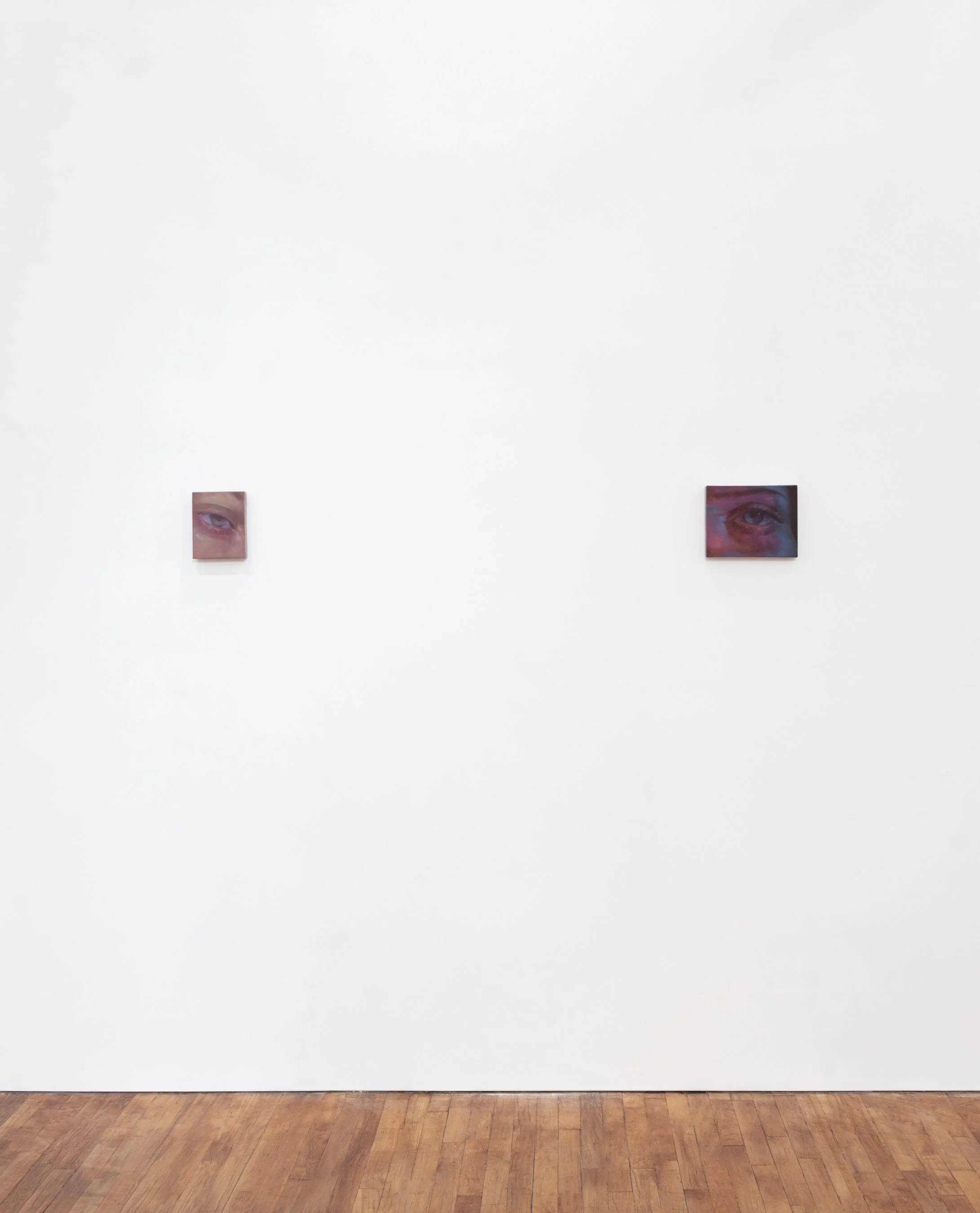
"Mute," Pei Wang
Tara Downs is pleased to present Mute the first solo exhibition by Pei Wang in the United States. In Wang’s intimate paintings, the filmic close-up and the fragment comprise the formal devices through which the artist produces photorealistic representations of the human form, conjures moments of narrative suspense, and constructs elaborate correspondences with the history of painting.
Like the artists of the Beaux Arts system, Wang began his painting practice by copying the Old Masters, and now draws upon more arcane material – film stills, found images, personal cellphone photos – to undergird his staging of contemporary affect. In these paintings, cultural memory and personal history intertwine, not only with one another, but also with techniques and materials drawn from the long tradition of painting. Borrowing a sense of light from the Baroque period or underpainting with casein, a material often used in ancient mural painting, the artist gestures toward a more expansive understanding of temporality than initially suggested. Just as the early modernists turned toward ancient or understudied cultures, rather than the classical, as sources of inspiration, particularly for figuration, Wang, too, takes on the role of the archeologist or anthropologist, collecting documentation of unexpected objects, and layering them upon somewhat unplaceable images culled from media culture.
As a scholar of medieval art, Wang has traveled across the Mediterranean – Greece, Cyprus, Algeria, Egypt – to inform his research, and this research has in turn altered his parallel work as an artist. The collision of disparate cultures, the development of art through its networked distribution, and the sense of hybridity engendered by their objects, are all themes of current medieval studies that resonate with the global character of contemporary art and culture. It makes sense here, too, that Wang looks to the respective studio methodologies of Zao Wou-Ki and Alberto Giacometti, and their cross-cultural friendship, as guide posts for his own activities. While many artists concerned with the global may submit themselves to prescribed understandings of contemporaneity, or succumb to illustrating current trends in critical theory, Wang works more closely in the lineage of these earlier figures, transcending any set notions surrounding cultural specificity through a broader array of study, and granting close attention to less obvious objects of scholarship. Indeed, such works function as compressive feats of aesthetics histories as much as they as operate as beguiling, technically-accomplished oil paintings. In this sense, The Fragment 02, 2023, may be emblematic, combining a sort of surreal take on the post-Impressionist ideal with the distortive, seemingly impossible figurative photography of Edward Weston.
Elsewhere, the recurrent motif of the eye, and its implicit, attendant literature relating to the gaze, brings us back to Wang’s use of photographic source imagery. Against the gleefully oppositional sense of appropriation that has marked the last half-century of artistic production, Wang works in a more subtle register, accurately recognizing culture as a far broader process of accumulation and cross-pollination. One would not immediately assume, for instance, that works such as Mute 30 an oil painting of a figure’s teary eye fastidiously rendered in extreme close-up, were derived from Man Ray’s photographic series of the same subject, Larmes de Verre, 1930–1932. The flat uncanniness of Man Ray’s image is exchanged for a more ambient sense of unease, although the compositional ambiguity, the logic of the fragment, remains. To interpret this act of translation as predominantly a shift in tonality may be to note the unexpected, propulsive contemporaneity of Mute 30 and other oil paintings by Wang much like it. For all their appeals to the past, these paintings ultimately operate in the present-tense, incisively embodying the emotive interiority of the artist today.
More information can be found here.

"Street Sellers," Lubaina Himid
Greene Naftali is pleased to announce Street Sellers, the gallery’s inaugural exhibition with Lubaina Himid. A pioneer of the Black Arts Movement in the 1980s, Himid is among the most celebrated British artists working today. Her expansive painting practice operates in the gaps of the historical record, lending lush visibility to issues of labor, migration, and the human toll of empire.
Himid’s latest cycle of paintings affirms the dignity of work through depictions of vendors who ply their wares, elegantly dressed and equipped with the tools of their particular trade. The figures emerge from a rich blend of temporalities and points of reference: from the hawkers that remain street-level fixtures of urban life, to popular prints of merchants and peddlers dating back to 17th-century London as rare documents of the working class. The genre of the full-length portrait—linked to aristocrats and monarchs—is also recast with new protagonists, shown on a grand scale and fully at one with their respective métiers. Asserting the centrality of Black subjects to art historical arenas long denied them, Himid frees herself to invent what the archive lacks: “I paint it into existence.
More information can be found here.

1-54 New York 2024
1-54 Contemporary African Art Fair is thrilled to announce the return of 1-54 New York, from 1-4 May 2024, its largest edition to date! Now in its 10th year, this edition will see 1-54 widen its dilating imprint upon the city by relocating to Chelsea, in the heart of Manhattan.
The fair will be held at the Starrett-Lehigh Building, at 255 11th Avenue. For nearly a century, the building has stood as a central point on Manhattan’s west side, acting as both a professional and cultural focal point in Chelsea, neighbouring vibrant hubs such as the Hudson Yards.
This year will bring together 30+ exhibitors presenting the work of over 70 artists from the continent and its diaspora. It is an event not to be missed!
More information can be found here.

"Recent Paintings," Philomena Wilson
The June Kelly Gallery is delighted to present Philemona Williamson in her fourteenth exhibition with the gallery. Recent Paintings reflects her longtime fascination with visual intrigues from personal to universal narratives between pubescent youth and the edginess of curiosity and uncertainty of adolescent maturity. The exhibition will open at 166 Mercer Street on April 18 and remain on view until June 4.
Williamson writes, “Recent Paintings is an exploration of personal, professional, and social transition. Anxiety, hope, curiosity, wonder, fear – the adolescent body becomes an intense crucible of passion and mystery as it experiences the unknown.”
Williamson’s gallery exhibitions have highlighted her concentration on pubertal development and its inevitable progression toward adulthood. She portrays the accompanying emotional stages—ambiguity, hesitancy, and vulnerability.
More information can be found here.

Lynn Hershman Leeson: "Anti-Aging"
Renowned artist Lynn Hershman Leeson invites audiences to embark on a transformative journey through time, identity, and the future of human existence with her latest exhibition, Anti-Aging. This is the artist’s third solo show with the gallery and presents a culmination of Hershman Leeson's decades-long exploration of this complex concept. The installation spans myriad forms— drawings, paintings, photographs, sculpture, multi-media works and video — from her earliest images depicting humans merging with machines to her latest experiments with bio-technology.
Hershman Leeson’s new video, Cyborgian Rhapsody: Immortality, 2023, makes its East Coast premiere introducing a cyborg named Sarah (born in 2029). Sarah is looking for human collaborators and finds them easily by infiltrating social media feeds. The cyborg interrupts two young girls, mid-scroll, with an inquisitive monologue telling the children about her military kin, misrepresentations of technology and the true threat to our consciousness: hatred and greed. Cyborgian Rhapsody is the follow-up to Hershman Leeson’s acclaimed 2022 film, Logic Paralyzes the Heart, 2022 which received Special Mention by the jury of the 2022 Venice Biennale.
More information can be found here.

"a place to be," Annabell Häfner
Place and non-place are rather like opposed polarities: the first is never completely erased, the second never totally completed; they are like palimpsests on which the scrambled game of identity and relations is ceaselessly rewritten.”
– Marc Auge, Non-Places: Introduction to an Anthropology of Supermodernity, p. 79
Annabell Häfner’s intimate paintings of architectural spaces emerge from hydrous washes of acrylic and delicate marks of chalk, rendering, draftsman-like, the more anonymous and liminal spaces of everyday life: the airport lounge, the corporate waiting room, or the hotel lobby. These are highly regulated spaces in which our sense of individualism begins to dissolve and render us anonymous, too; they are prone to induce boredom or impatience, but may also offer a brief respite, a moment of calm between contingent, consequential events.
a place to be, Häfner’s first solo exhibition in the United States, draws upon the anthropologist Marc Augé’s notion of “non-place,” the interstitial places – airports and hotels, metro stations and supermarkets – that have increasingly defined quotidian experience since the advent of modernity. Augé’s 1992 study from which the concept originates, Non-Places: Introduction to an Anthropology of Supermodernity, coincided with the rise of the jet-set, exhibition-oriented, MacBook-toting artist, who found in Augé an apt description of the frenzied, paradoxically hyperconnected and isolated, lifestyle to which she submitted herself. But while such artists often reproduced the sleek sterility of non-places, what is novel and singular to Häfner is the affective register in which her works unfold: a narcotic, or even hypnagogic, dimension in which the dissociative potentialities of such sites come to the fore.
This dialectic is already apparent in the phrase “A Place to Be,” which suggests both a sort of distracted busyness (for instance, “can’t talk, I’ve got places to be”) as well as the more contemplative or existential associations conjured by the elemental verb “to be.” It’s in the shift from “non-place” to “place to be” where Häfner’s paintings locate their raison d'être, a shift from a possibly reductive, illustrative approach to their source material to a deeply beguiling form of experiential mapping.
The works’ emotive uses of color – broad striations of pale green, marigold, and cherry-red – function both as admirably as painterly abstraction as they do replicate the “continuous temporality” of long-distance travel, the simultaneous sunrise and sunset experienced by the redeye passenger. Another pleasurable sort of ambiguity emerges from compositions such as place to be 57, which might contain a Magrittian inversion of sky and ground, or otherwise generates a conflation of inside and outside, but then also puts us in mind of the glass panes and infinity pools synecdochally related to luxury real estate. It speaks to Häfner’s remarkable economy of means that the artist is able to generate such associations, or elsewhere render suggestions of furniture – side tables, sofas, communal benches – from a few planar elements and structuring lines of chalk, producing sparse reconstructions of these sites that register in the collective memory. Depicting expansive, even excessive, fields of space at an approachable scale, Häfner produces an oddly moving, haptic encounter. These works draw us closer, in toward unexpectedly affective compositions, as if headed somewhere in advance of nowhere.
More information can be found here.

"Off The Cuff," Erica Baum
Bureau is proud to announce the inaugural exhibition at 112 Duane Street, Off The Cuff, by Erica Baum, the artist’s sixth solo show with the gallery, featuring her latest series, Fabrications.
Over the past three decades, Erica Baum has focused her practice on capturing serendipitous instances of found poetry, incidental beauty, and humor, which would otherwise go unseen. The Fabrications series has grown out of the artist’s recent body of work, Patterns, which looks closely at the graphic qualities, textures, and compositions of the tissue-like printed layers of sewing guides. In looking for this type of vintage pattern over the past several years, Baum collected numerous specialty magazines from the 60s and 70s aimed at the domestic housewife, featuring fashion, sewing, cooking, and home hobby projects. These pages contained a wealth of material, from elegant and stylish spreads to positively zany handmade creatures. Baum’s photographic fabrications recognize and amplify the materiality of her subject matter—both the textiles depicted and the printed paper sources themselves. The new pieces are composed from fragments and slivers of the magazines’ pages, and the resulting works embody a mysterious or whimsical sense of elegance. Many of the greyscale works feature glimpses of the human figure reminiscent of those from her celebrated Naked Eye series. The more colorful works offer levity with vivid slashes of halftone color, filled with unusual materials and bizarre characters.
While the idiom “off the cuff" is popularly understood as an expression suggesting improvisation, it evolved out of a need for certainty. The phrase’s apocryphal origin story comes from early 20th-century vaudeville, when actors scrawled words onto their detachable cuffs to remember their lines. The phrase's history, which once meant to stay on script but now means its opposite, resonates with Baum's playful manipulation of the printed word, and its unfolding meaning within the context of texture and fabric.
Baum’s Fabrications series is also the subject of her recently published, limited edition Artist Book with Three Star Books, Paris, which has been acquired by numerous institutions including the Museum of Modern Art, New York; Whitney Museum of American Art, New York; The Tate, London; Getty Museum, Los Angeles; The New York Public Library, New York; CCS Bard, Annandale-on-Hudson, New York; Frac Sud, Marseille; among others. The gallery will host a reading with poets Kim Rosenfield and Laynie Browne in the exhibition on March 29th, 2024 at 6:30 PM.
More information can be found here.

Nona Faustine: White Shoes
“What does a Black person look like today in those places where Africans were once sold, a century and a half ago?” asks artist Nona Faustine (born 1977). Using her own body, she interrogates this question in her photographic series White Shoes. Forty-two self-portraits show Faustine standing in sites across New York City, from Harlem to Wall Street to Prospect Park and beyond, that are built upon legacies of enslavement in New York—one of the last Northern states to abolish slavery. On her feet are a pair of sensible white pumps, which speak to the oppressions of colonialism and assimilation imposed on Black and Indigenous peoples locally, nationally, and globally. Otherwise nude, partially covered, or holding props, Faustine is at once vulnerable and commanding, standing in solidarity with ancestors whose bodies and memory form an archive in the land beneath her shoes.
Nona Faustine: White Shoes is the artist’s first solo museum exhibition and the first complete installation of this consequential series. Born and raised in Brooklyn, Faustine urges us to think critically about the hidden, often traumatic histories of the places we call home. As such topics are being erased from public school curricula nationwide, this display is a moment to consider the enduring impact that the past has on our present.
More information can be found here.

Two Films by Jocelyne Saab
There is no Lebanese nation, they say to her; it is 1975 Lebanon, the southern border with the Zionist state is a sieve of frontier violence; monopolistic capital is running roughshod over Saida’s fishermen’s unions; former political prisoners are organizing against the felling of berry trees in Tripoli; the tobacco harvests of the south remain an exercise in back-breaking exploitation; the Palestinian camps seethe under the thumb of the criminal peace; a belt of misery surrounds Beirut, with hundreds of thousands of dispossessed forced to watch the shiny cars driving technocrats and Christian fascists to their tennis matches. These were among the conditions that would catalyze a working-class revolution, the perambulatory gusts of the wars that would consume the country for three decades.
Jocelyne Saab commits this all to film in her documentary Lebanon in a Whirlwind, which travels across land, speaking to laborers, political leaders, and students. Through interviews and footage of daily life, Saab analyzes the institutions of the Lebanese left and Palestinian resistance as they grow into a popular front against the state, which called for the dismantling of Lebanon’s bourgeois-representative system and a recommitment to anti-colonial struggle against Zionism, Western imperialism, and Arab reaction. In a trim seventy-five minutes, Saab captures the revanchism of class power against people organizing for their survival, which at this particular conjuncture took the name of the “two-year war” (harb as-sanatayn).
Saab was twenty-seven years old then, already consumed by the stories of precipice and catastrophe across the Arab world, which had become her filmic project. That same year, Saab made Rejection Front, an unsparing documentary short filmed in the tunnels of an underground training camp for Palestinian militants fighting against the conciliatory policies of the then-PLO leader Yasser Arafat. In it, Saab interviews Nayef Hawatmeh, of the Democratic Front for the Liberation of Palestine (DFLP) and Ahmed Jibril, of the Popular Front for the Liberation of Palestine – General Command (PFLP–GC).
In the early draft of her shooting scripts, Saab wrote of herself: “Me, personally, I have never handled a weapon, let alone felt the need to buy one or use one. And yet today, I am armed. Armed like the rest of the world.” The question for what haunts the country. Today, as the Zionist and Western imperial powers resume their bombing of Lebanon and the south, as they accelerate their genocide of the Palestinian people, there is one answer. But there are others too, tucked into the folds of a geography of struggle and refusal.
More information can be found here.
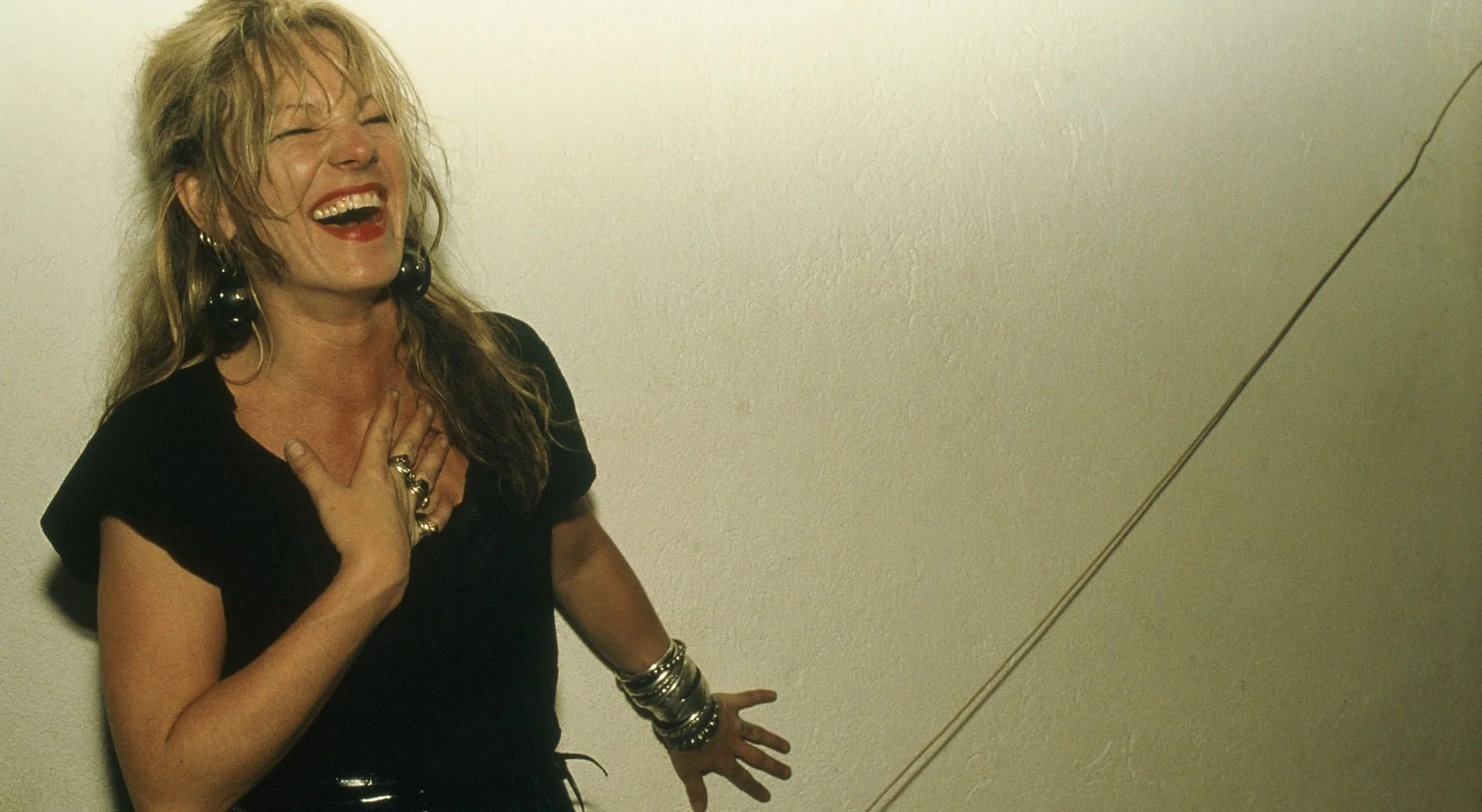
Cookie Mueller at 75
“Why does everybody think I’m so wild?” Cookie Mueller (1949-89) wondered in one of her short stories, collected in Walking Through Clear Water in a Pool Painted Black (1990, 2022). “I’m not wild. I happen to stumble onto wildness. It gets in my path.”
Join The Poetry Project at St. Mark’s for a celebration of Cookie Mueller’s 75th birthday. We’ll read selections from her remarkable, incisive body of work, as well as writing that takes its cue from her singular irreverence. Readers include Gary Indiana, Amos Poe, Jackie Ess, Chi Chi Valenti, Lizzi Bougatsos, Kris Lee, Gia Gonzales, and Nicole’s Revenge.
More information can be found here.

Maren Hassinger
Spanning over five decades, Maren Hassinger’s practice integrates performance, sculpture, fiber arts, and installation, often blurring the boundaries between these mediums. The artist’s signature use of industrial wire rope began in the 1970s—while pursuing her master’s degree in fiber structure at the University of California, Los Angeles—when she encountered the material in a junkyard. Since then, she has consistently manipulated the material to both physically and conceptually tease out its organic attributes. Now at Dia Beacon, exhibited for the first time in nearly 40 years and in its never-before-seen entirety of 182 components, Field (1983) articulates Hassinger’s central formal and conceptual concerns. Comprised of wire-rope bundles meticulously unraveled to resemble feathered metal stalks planted in cement bases, the piece evokes, in the artist’s words, an “industrial field” where human-made products emulate nature in its absence, beckoning a reconsideration of one’s relationship with organic forms across both natural and built environments.
More information can be found here.

Ellen Cantor, JOY OF LOVE
Ellen Cantor (1961–2013) was an American artist.[1] Cantor was known for combining pornography, politics, pop culture and the handmade in her paintings, drawings, sculptures, videos, and films. Born in Detroit, Michigan to a Jewish family, Cantor completed her studies at Brandeis University in 1983 with a degree in painting. She went on to study at the Skowhegan School of Painting and Sculpture in 1991.
More information can be found here.

Tang Shu Shuen's The Arch
Set in 17th Century China, this film is considered the first art film in the Chinese language. The Arch (Dong fu ren) focuses on a wealthy widow (Lisa Lu) in the early Qing dynasty on the eve of her crowning achievement, the erection of a triumphal arch in honor of her many good works. Though her film career was brief, Cecile Tang, (Shu Shuen) was a trailblazer for socially critical art cinema in Hong Kong’s populist film industry, as well as its first noted female director. Shot by Indian director, Satyajit Ray’s regular cinematographer, Subtrata Mitra, and edited by Les Blank.
More information can be found here.
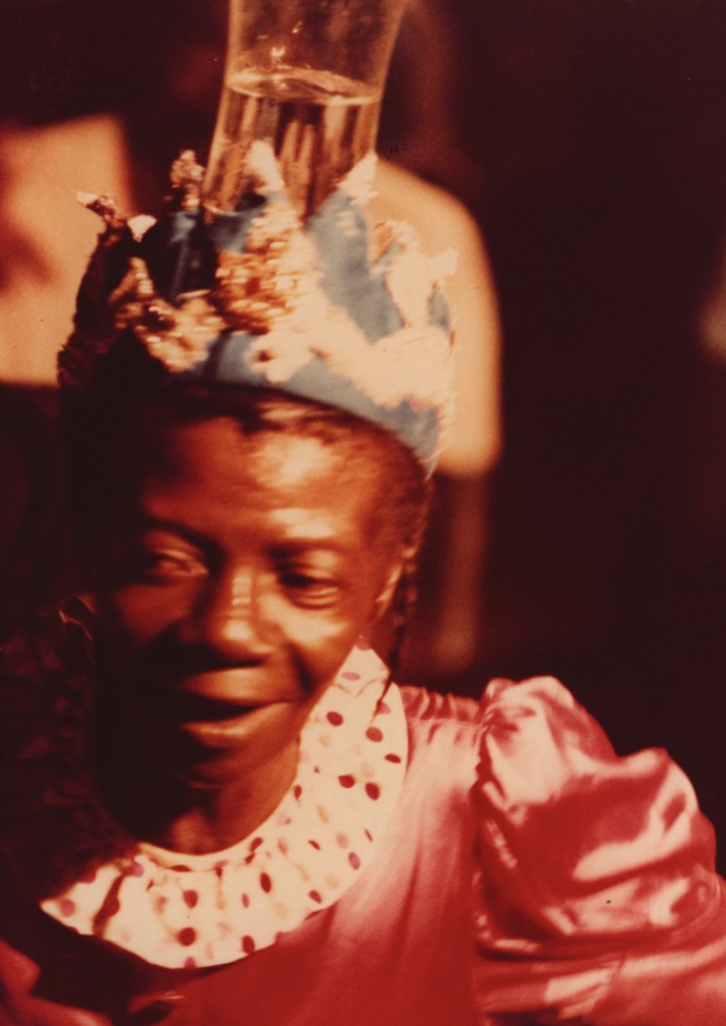
Kumina Queen by Nyasha Laing
Imogene “Queenie” Kennedy was a priestess in post-colonial Jamaica who catapulted her African spiritual practice into renown. But after centuries of erasure, what remains of the dance between the living and the dead? In the wake of the loss of her mother, documentary filmmaker Nyasha Laing travels into the heart of Jamaican countryside to research the ancestral ritual of Kumina. Her journey uncovers a mysterious world that reveals a divergent pathway to freedom, healing, and transformation—for those who choose it.
More information can be found here.

Blind Date: Tiny Conversation Hearts
Just a few days before Valentine’s Day, 2024 Suzanne Fiol Curatorial Fellow and interdisciplinary artist Lina Azalea Dahbour presents the first program in her “Blind Date” series—Tiny Conversation Hearts.
Tiny Conversation Hearts asks four performers to complete a series of risky tasks: take a singular score (in this case, a newly commissioned score by choreographer Alexa West), go home by their lonesome, create a piece based on the score, and show up on the night of the event to perform their piece at the same time as another artist working in a different medium, with no knowledge of the other artist’s plans.
In an attempt to depart from the mono dynamic, algorithmically feasible pairings modern technology seeks to offer us, Dahbour has selected two dancers and two musicians with differing and distinctive voices to be paired in this first dance/music cross-genre “Blind Date” experiment. Conceptually oriented, multimedia dance artist Dominica Greene is paired with cathartic, aural channeler Nyhne; geometrically-minded movement investigator Emily Kessler is paired with sonic collagist Holy People.
More information can be found here.

Publishing Expanded: Where Is Africa
Publishing Expanded: Where Is Africa is the first gathering in CARA’s annual, interdisciplinary winter program celebrating the release of the organization’s new and upcoming publications. This inaugural, multi-day program will take place at CARA from February 9-11, 2024 on the occasion of the launch of Where Is Africa, edited by Emanuel Admassu and Anita N. Bateman, designed by NMutiti Studio, with a foreword by Mabel O. Wilson.
In 2017, curator and art historian Anita N. Bateman and architect and professor Emanuel Admassu initiated research on the traditional (mis)positioning of the arts across the African continent. Where Is Africa has been an extended set of exchanges with contemporary artists, curators, designers and academics who are actively engaged in representing the continent—both within and outside its geographic boundaries. This publication is also a conceptual project that accompanies a conceptual place, driven by the desire to dislodge Africa from categorical fixity and the representational logics of nation-states.
More information can be found here.
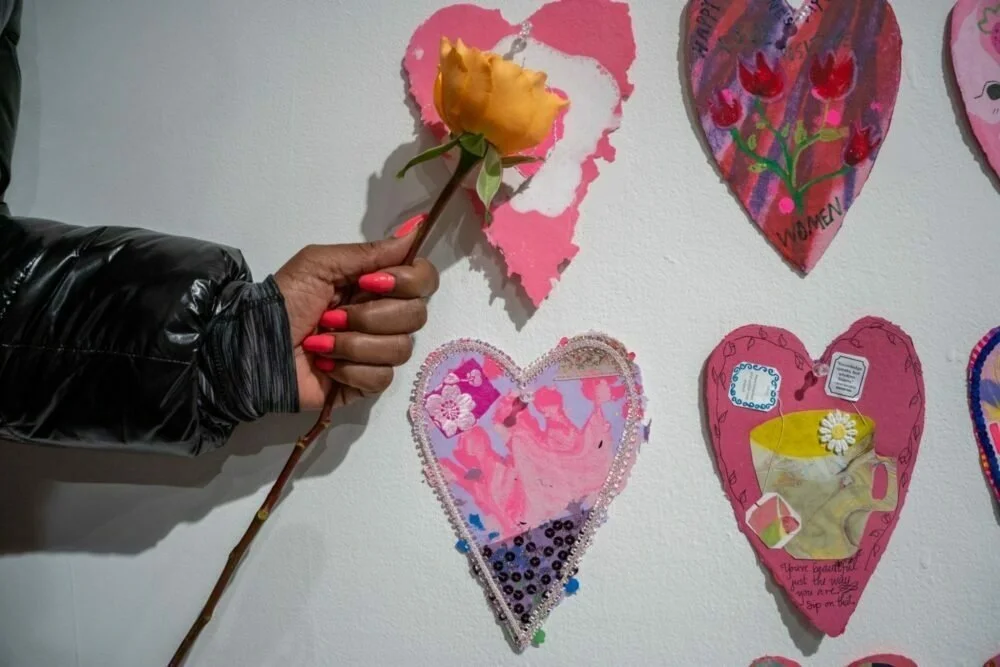
Love Positive Women 2024 An Exhibition Of 600+ Handmade Paper Valentines
Love Positive Women is an international series of events that uses Valentine’s Day as a backdrop, creating a platform for individuals and communities to engage in public and private acts of love and caring for women living with HIV. LOVE POSITIVE WOMEN is an ongoing project established by Visual AIDS artist member Jessica Whitbread in 2013.
After the activation, the Valentines will be mailed around the world to HIV-positive women in time for Valentine’s Day. Women living with HIV often experience isolation and stigma and face specific challenges around relationships, motherhood, and healthcare. Since 2015, the project has distributed over 3,500 cards in order to fight stigma, create community, and empower women living with HIV.
More information can be found here.

Screening: Mambar Pierrette by Rosine Mbakam
Though Mambar Pierrette represents the first fictional feature by French-Cameroonian filmmaker Rosine Mbakam – who visited Anthology in 2019 to present theatrical runs of her remarkable THE TWO FACES OF A BAMILEKE WOMAN and CHEZ JOLIE COIFFURE – the new film closely resembles her earlier films in its observational, de-dramatized focus on daily life and its dedication to portraying a strong-willed, unapologetic, and charismatic female protagonist. With the beginning of the school year in the city of Douala, a long line of customers come to Mambar Pierrette, the neighborhood dressmaker, to have their clothes ready for upcoming social events and ceremonies. More than a seamstress, Pierrette is the confidant of her customers. But when it starts pouring and the rain threatens to flood her workshop – one of many misfortunes she will be forced to bear – Pierrette struggles to stay afloat.
More information can be found here.

Amelia Umuhire: African Film Institute Film Series
Taking a cue from the practice of an evening school as proposed by Christian Nyampeta’s Ecole Du Soir, Nsabimana invites filmmakers, artists, and scholars for a meditation and conversations around “African Cinema,” unfolding at e-flux Screening Room over the course of twelve months. What does the formulation evoke for us today? Is it worth holding onto? For whom? Comprised of a series of viewings sometimes followed by conversations, the curation will include feature films, shorts, and documentaries.
Umuhire’s experimental short film Mugabo (2016) and her award-winning radio documentary Innocent (2020) are excellent points of entry into “African cinema.” Moving between Rwanda, Germany, and Belgium, and in multiple languages, her work invites us to expand our imagination. Umuhire shows us how to tell stories centered on a geography (Rwanda) while also moving across time, space, and tongues.
More information can be found here.

Cauleen Smith: The Wanda Coleman Songbook
The Wanda Coleman Songbook is an immersive video installation that enlists scent, sight, and sound to explore the multidimensional depth of poems by Wanda Coleman (1946–2013). Coleman was widely considered the unofficial poet laureate of Los Angeles, and her work guided Smith’s reacquaintance with the city after a sixteen-year absence. At the heart of The Wanda Coleman Songbook listening room, visitors are invited to drop a needle on the eponymously titled, limited-edition two-color vinyl 12-inch EP with commissioned contributions by Kelsey Lu, Shala Miller, moor mother and Aquiles Navarro, Meshell Ndegeocello, Jeff Parker and Ruby Parker, Alice Smith, and Jamila Woods and Standing on the Corner.
More information can be found here.
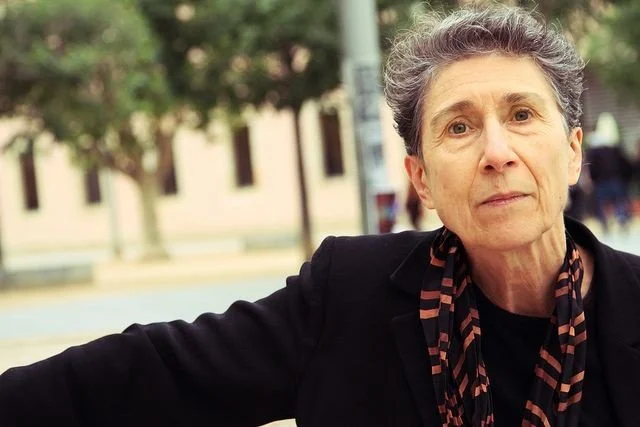
Silvia Federici War, Social Reproduction, and Anti-Capitalist Feminist Struggle
Silvia Federici (b. 1942, Parma, Italy) is one of the most influential theorists of her generation. In 1972, she co-founded the International Feminist Collective (IFC), leading its New York Committee. The IFC launched the Wages for Housework campaign in the US and abroad, appropriating labor union tactics such as the general strike to draw attention to gendered, unwaged care work and advocate for women’s healthcare, reproductive rights, and sex work. Its efforts established precedent for current debates on the socio-sexual division of labor, sexuality as work, stratified power relations among women, and the intersectionality of these struggles. Federici has been active in the anti-globalization movement and the anti-death penalty movement. Her published works include Revolution at Point Zero (September 2012); Caliban and the Witch: Women, the Body and Primitive Accumulation (2004); A Thousand Flowers: Social Struggles Against Structural Adjustment in African Universities (2000, co-editor); and Enduring Western Civilization: The Construction of Western Civilization and its “Others” (1994, editor). Federici is Professor Emerita of Political Philosophy and International Studies at Hofstra University in Hempstead, New York.
Event postponed, more information can be found here.

Shilpa Gupta: I did not tell you what I saw, but only what I dreamt
Mumbai-based artist Shilpa Gupta has created a body of work that is shaped by her interest in research, pedagogy, and learning as an open-ended and reciprocal dialogue with the communities with which she interacts and with the public that explores her work.
This project functions as a script for reading a constant theme throughout her practice: language and its forms of control and operation. Mediated by specific structures based on race, gender, class and religion, language conditions geopolitical borders and shapes political relations, as well as subjective imagination, and the ability to interpret different social landscapes.
For her exhibition at Amant, Shilpa will present new commissions to go alongside past works, and a series of educational projects, focusing on what could be called the “reverse” of discourse the absence of language, or what cannot be said. As Shilpa suggests, this reversal “can take place in an authoritative mode of history writing and censorship, or simply even in how our actions are largely controlled by the unconscious”.
Interested in day-to-day materials, she often uses techniques borrowed from social psychology designed to map individual and collective behaviors through definitions, data, or symbols. In so doing, her work points to how language often camouflages emotions and lived experience. That is why the space of literature, poetry, and dreams also becomes an open playground within her work. She opens up what she calls “a space between our desires and our realities, of which we do not know enough” and so facilitates new possibilities and hopes, counteracting the experience of censorship.
A series of educational projects, past and present, form an integral part of the exhibition, and allow the creation of different dialogues and forms of interaction with a variety of audiences, especially the youngest, in a critical as well as interactive way.
More information on the event can be found here.

Marta Minujín: Arte! Arte! Arte!
The first survey exhibition in the United States of Marta Minujín, a defining force of Latin American art whose trajectory intersected with the major artistic developments of the postwar period while reflecting a singular spirit and vision infused by her sharp intellect, irreverent humor, and performative presence.
Marta Minujín: Arte! Arte! Arte! will include nearly 100 works organized to reflect Minujín’s bold experimentation over six decades. The exhibition will chart Minujín’s influential career in Buenos Aires as well as time spent in Paris, New York, and Washington, DC, through a range of pioneering, mattress-based soft sculptures; fluorescent large-scale paintings; psychedelic drawings and performances; and vintage film footage. The artist’s ephemeral works – happenings, participatory installations, and monumental public art – will be presented through rarely-seen photographs, video, and other documentation.
Minujín established an international reputation as a key artistic voice at a young age. Born to a Russian-Jewish family in 1943 in Buenos Aires, Argentina, Minujín began her career in the late 1950s creating cardboard constructions and roughly hewn paintings. By the early 1960s, she had started to experiment with mattresses, creating colorful soft sculptures that would come to define her signature style. Today Minujín is one of Argentina’s most recognized artists and celebrated cultural personalities. She continues to produce multimedia installations, participatory events, paintings, and sculptures, attesting to her unceasing versatility. Well into the twenty-first century, Minujín’s art persists with vital force, critical vision, and clarity of purpose.
More information on the event can be found here.

Copy Machine Manifestos: Artists Who Make Zines
This exhibition contains graphic content and language. Viewer discretion is advised.
Copy Machine Manifestos: Artists Who Make Zines is the first exhibition dedicated to the rich history of five decades of artists’ zines produced in North America. Since the 1970s, zines—short for “fanzines,” magazines, or self-published booklets of texts and images, usually made with a copy machine—have given a voice and visibility to many operating outside of mainstream culture. Artists have harnessed the medium’s essential role in communication and community building and used it to transform material and conceptual approaches to art making across all media. This canon-expanding exhibition documents zines’ relationship to various subcultures and avant-garde practices, from punk and street culture to conceptual, queer, and feminist art. It also examines zines’ intersections with other mediums, including collage, craft, film, drawing, painting, performance, photography, sculpture, and video. Featuring nearly one thousand zines and artworks by nearly one hundred artists, Copy Machine Manifestos demonstrates the importance of zines to artistic production and its reception across North America.
The exhibition is accompanied by the first comprehensive publication to explore artists’ zines, co-published with Phaidon Press, and including over 800 images of zines and works in other media alongside texts by the curators and specially commissioned essays by Gwen Allen, Julia Bryan-Wilson, Tavia Nyong’o, Alexis Salas, and Mimi Thi Nguyen, as well as an extensive section featuring biographies of all the artists represented in the project.
More information on the event can be found here.

A Dark, A Light, A Bright: The Designs of Dorothy Liebes
American textile designer, weaver, and color authority Dorothy Liebes (1897–1972) had a profound influence across design fields, helping to shape American tastes in areas from interiors and transportation to industrial design, fashion, and film. The “Liebes Look”—which combined vivid color, lush texture, and often a glint of metallic—became inextricably linked with the American modern aesthetic.
From the 1930s through the 1960s, Liebes collaborated with some of the most prominent architects and designers of the time, including Frank Lloyd Wright, Henry Dreyfuss, Donald Deskey, Raymond Loewy, and Samuel Marx. Fashion designers, including Pauline Trigère, Adrian, and Bonnie Cashin, also used her fabrics, yielding some of the most distinctively American fashions of the mid-20th century.
Despite widespread recognition during Liebes’s lifetime, her powerful impact on 20th-century design remains largely unacknowledged. Featuring more than 175 works—including textiles, textile samples, fashion, furniture, documents, and photographs—this exhibition reveals the scope of her achievements and adds a new thread to the story of mid-century modernism.
More information on the event can be found here.

Pegeron: Tatiana Florival
Baxter St at the Camera Club of New York is pleased to announce Pegeron, the first solo exhibition of films, video collages, paintings, and sculptures by Baxter St 2023 Resident Tatiana Florival. Works on view in this exhibition explore Florival’s personal family history, as it intersects with broader narratives about American history, particularly the Black experience in America and Black nostalgia.
Florival engages in a lens-based practice of world-building by animating and reinterpreting her family’s photo archive. The resulting works reflect both the seemingly self-contained world of the artist’s family and the ways in which public narratives influence and intertwine with private histories. Based specifically on Florival’s grandfather’s old photographs, her works draw a lineage between her own hand and the hands of her ancestors.
While dominant narratives in American history play an important role in the exhibition, Florival is also interested in the blending of real and imagined stories, gesturing toward the malleability of memory and storytelling. Created across mediums and formats, works are materially expansive and technically acute. Sculptural video tableaus, for example, carefully connect original photographs with newly created forms and content. Tableau scenes show images rooted in reality, such as model ships sinking, American soldiers parachuting into Vietnam, and young black girls getting their hair braided, while also including more fantastical scenes like giant monsters situated in trees. In this sense, Florival’s artworks contend with truth while being governed by a different set of rules than those at play in the everyday world.
While Florival’s work deals with trauma, violence, and war, moments of joy and fun play an important and revelatory role. In her film, The Adventures of Manboy and Bushie, two time-traveling detectives go on a Space Time Mission instead of being drafted to the Vietnam War. In this work, Florival pointedly draws on her grandfather’s Black American experience by riffing on old Western films. The work recalls her grandfather’s love for watching Westerns, while also critiquing the genre’s inherent racism and colonialism. For the artist’s grandfather, watching the films ignited a desire for an imagined, ahistorical past. In the suspended reality of The Adventures of Manboy and Bushie, Florival’s grandfather reaches toward that desire to insert himself into any time or place, existing without violence, while black, throughout the history of America.
More information on the event can be found here.

Herstory: Responses to “The City of Ladies”
Judy Chicago’s “The City of Ladies” installation brings together the work of over eighty women and genderqueer artists from across centuries, contextualizing Chicago’s practice within a genealogy of feminist art-making.
For this evening of talks and conversations, we’ve invited a new generation of writers and thinkers to make their own connections with the alternative art history canon presented in “City of Ladies.” Speakers will take up individual works and themes in the installation, addressing motherhood, the erotic, feminist activism, and the performance of gender through personal responses.
Scholar Sophie Lewis, poet Simone White, and novelist Kate Zambreno will each speak in response to a work featured in the installation, followed by a conversation with moderator and exhibition co-curator Madeline Weisburg.
Sophie Lewis (they/she) teaches courses on critical theory at the Brooklyn Institute for Social Research and has a visiting affiliation with the Center for Research in Feminist, Queer and Transgender Studies at the University of Pennsylvania.
Simone White (she/her) is a poet and critic based in New York. She is the author, most recently, of the book-length poem or, on being the other woman (Duke, 2022) and the companion critical book Warring (forthcoming from Duke).
Kate Zambreno is the author of many books, most recently The Light Room, a meditation on art and care (Riverhead, 2023), and Tone, a collaborative study with Sofia Samatar (Columbia University Press, 2023).
More information on the event can be found here.
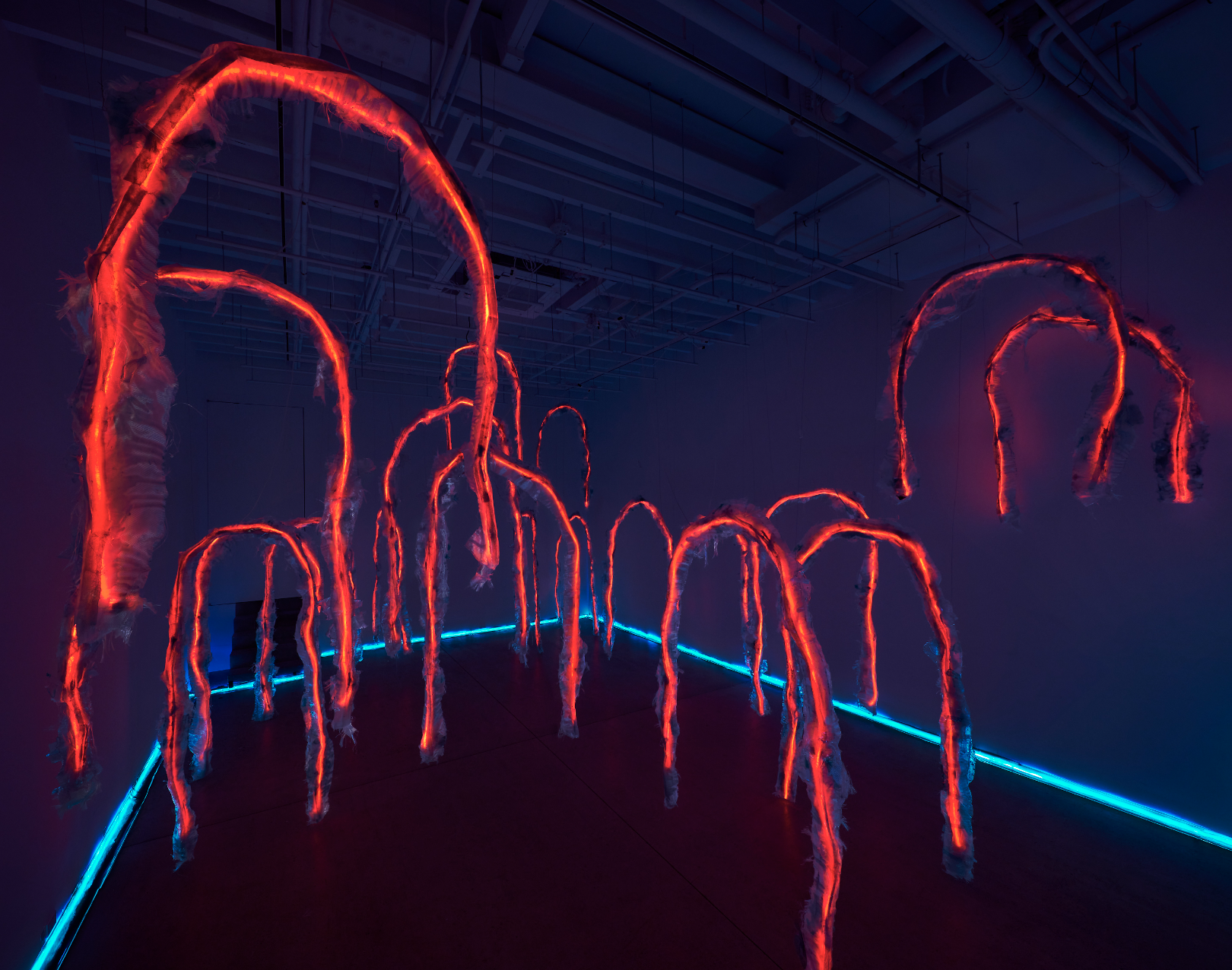
Tiril Hasselknippe: Hyperstate
Tiril Hasselknippe (b. 1984, Arendal, NO) is a sculptor working with steel, concrete, fiberglass, and resin who proposes object-based solutions to evade humanity’s downfall and whose sculptures command authority of physical presence through their sheer volume, scale, and weight. Her sculpture is rooted in material and textual world that balances deeply personal exploration with socio-political underpinnings—at times seeming to participate in parts of a post-apocalyptic storyline. Hasselknippe creates a kind of science fiction of formalism in which the double bonds between the sacred and the primitive, the natural and artificial, and the life-giving and the downfall are all present. Hasselknippe received her BFA and MFA from Malmö Art Academy in 2011 and 2013 respectively.
She also participated in a foreign exchange program at The Cooper Union in New York in 2010. Hasselknippe’s recent solo exhibitions have been held at institutions including Kuntshall Stavanger, NO; NITJA Senter for Samtidskunst, Lillestrøm, NO; Kunstnerforbundet, Oslo, NO; Magenta Plains, New York, NY; Kunstverein Braunschweig, DE; Bianca D’Alessandro, Copenhagen, DK; and DREI, Cologne, DE. Her work has recently been included in group exhibitions at the Malmö Konstmuseum, Malmö, SE; New Museum, New York, NY; Magenta Plains; Künstlerhaus Palais Thurn & Taxis, Bregenz, AT; A Palazzo Gallery, Brescia, ITL; Astrup Fearnley Museum of Modern Art, Oslo, NO; and the Vestfossen Kunstlabratorium, Vestfossen, NO. Hasselknippe lives and works in Stavanger, NO.
More information can be found here.

CURRENTS: Free Expression and the Inexpressible
A.I.R. Gallery is pleased to announce Free Expression and the Inexpressible, the eighth edition of CURRENTS, a biennial open call exhibition series in which artists respond to current topics. Curated by artist and theorist Aliza Shvarts, the 2024 iteration of the series addresses how artists navigate the paradoxes and promises implied by the idea of “freedom of expression.”
“Freedom of expression” is a principle and right that is meant to protect the voices of the disempowered. Crucially, it promises to safeguard our capacity to speak truth, critique systems of power, and demand a better world. Yet free expression has never been a right without exception, or even a right enforced and distributed equally. At times, the freedom of expression of some comes at the silencing of others—particularly women, queer people, people of color, indigenous people, and people with disabilities. In these instances, “freedom” can be an alibi for reinforcing domination: a term invoked to defend hate speech and otherwise disavow language’s violent effects.
We are living through a dramatic repolarization of the cultural debates over the meaning of free expression. Between the alarming rise in book bans, attacks on academic freedom, and legislation such as Florida’s “Don’t Say Gay” law, there has been an unprecedented escalation in censorship and dismantling of First Amendment protections. At the same time, cancel culture, misinformation, and deep fakes have prompted us to reconsider the social responsibility that comes with freedom, while the advent of AI-generated text and images adds further dimension to the age-old question of what it means to “express.” How in this moment do we navigate the paradox and promise of freedom of expression as an alternately liberatory, retaliatory, and mutable idea?
More information can be found here.

Barbara Wesołowska: Father
Barbara Wesołowska’s deeply personal paintings conceal, layer, erase and uncover in a process that she describes as “solving a problem”, as “correcting errors in a series of accidents”. The heavily textured oil paintings emerge from abstract spills and layers, rubbed and sanded down, painted over again and finished when Wesołowska is met with a redeeming feeling of acceptance, with a sense of ease. Throughout a turbulent process of acting and reacting, the paintings reveal a multitude of human faces which Wesołowska ‘finds’ within the density of the paint, merely pronouncing what’s already there.
More information can be found here.
To access events prior to May 2023, click here.
